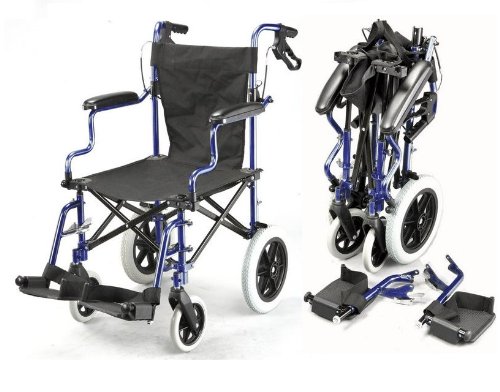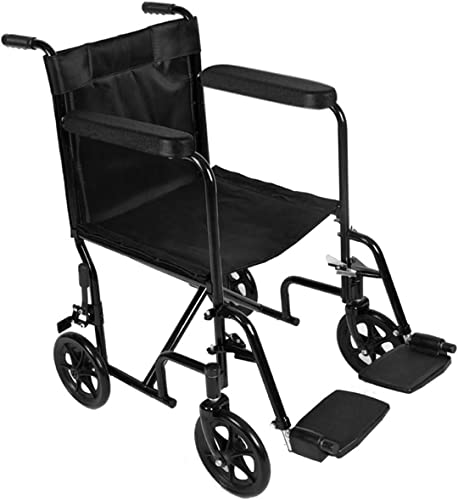The 10 Most Scariest Things About Folded Wheelchair
페이지 정보

본문
 Buying a Folded Wheelchair
Buying a Folded Wheelchair A wheelchair that folds is perfect for those who travel frequently on a basis or have a small living space. This allows them to take their wheelchair on holiday or into public transportation.
A wheelchair that folds is perfect for those who travel frequently on a basis or have a small living space. This allows them to take their wheelchair on holiday or into public transportation.Begin by turning off and disconnecting the power (if applicable). Find a safe place to spread the chair and clear the area of obstructions.
Seat and Handlebar
The handlebars of a wheelchair can be easily folded down by pulling a lever located on the back of the chair. The user can lower the footplates then swing them out to allow space for standing transfers. This is also helpful for putting the chair underneath a table or desk. Some chairs have armrests that can be removed to give a more elegant appearance and to transport the chair in smaller vehicles.
When preparing to fold up a wheelchair, the very first thing a user must do is ensure that all locks and pins are secured. This will prevent the wheelchair from disengaging during transport or causing damage to other items in a car.
The majority of ultra lightweight folding wheelchairs uk wheelchairs have the cross-brace design that collapses the frame by pushing the sides together. There are other options for collapsing wheelchairs such as scissor brackets that fold the seat in half. There are also "quick-release axles" that make it easier to place the chair in small spaces.
Before attempting to fold the wheelchair, the user should always be sure to examine it for signs of wear and tear and any adjustments that might be needed. This will not only extend the lifespan of the chair, but also prevent any unexpected problems during transportation or storage.
Rigid Wheelchairs are constructed with a solid frame and can be folded up into a box to be transported and stored. These are made of aluminum or titanium and offer an incredibly responsive feel because they do not flex when the wheelchair is being pushed. This could reduce the amount of energy is required, and some users feel that it gives them a greater feeling of control.
Before attempting to fold up a rigid wheelchair, the user should inspect it for signs of wear and tear or any adjustments that might be required. This will enable the user to determine whether they require to lift or lower the footplates, and then adjust the legrests. Before making any adjustments to the wheelchair, it's crucial to consult physical therapist. This could affect the user's ability to stand and move.
Uprights
The uprights are the shorter arms near the middle of the wheelchair frame, just below the point where the seat joins the backrest. They must be clearly marked as the "uprights" or "hinges," and are usually a little higher than the armrests. It is important to properly identify and align these components of the wheelchair in order that they will remain in the desired, folded position.
Wheelchairs that can be reduced in size to make them suitable for storage and transportation are known as collapsible or lightweight folding self propelled wheelchair wheelchairs. They are usually self-propelled, and come with a foldable backrest to reduce height as well as an X-shaped vertical frame to reduce width. The steerable front wheel and rear load wheels are mounted on brackets that pivot on upper and lower bars of the sidewalls which also help support the uprights.
The links 61 and62 are strained when the chair is fully open (see the figures. 2 and 3) of each slide are tensioned and the uprights 9 are unable to be moved in relation to one another, even when the handles 16 are in the raised positions. When the wheelchair is semi-folded, the uprights are moved forward by moving the slides on the front and back axles, respectively.
If the seat's depth is too short, it will cause the wheelchair user to sit in a wrong position and may not be able to relieve the pressure on their thighs. This can lead to pressure ulcers. To check if the seat is deep enough, measure the distance between the pelvis' back to the onset of the pre-seat bone shelf.
After the wheelchair has been properly positioned, it should be secured and locked. This will help prevent any injury or damage that might occur during storage or transport. The wheelchair must be inspected multiple times to ensure that the locking mechanism is working correctly. This is crucial for wheelchair users with poor sensation in the thighs or toes, as an unintended movement during transport or storage could result in serious injuries. After the wheelchair is locked and secured, it can be safely stored in its travel bag.
Seat and Backrest
A wheelchair's seat and backrest are designed to offer stability, support, and pressure relief. They also help to prevent ulcers, pressure sores and help ease the discomfort of those that spend prolonged periods of sitting. Backrests and cushions for chairs are available in a variety of different shapes, sizes, fabrics and materials. For comfort, foam air cushions, or gel are available. Combination foam/gel and air cushion options offer a more customized solution that ensures stability and pressure distribution.
The ideal wheelchair for you depends on the setting you will be using it in, as well as the specific requirements you have. Your doctor will guide you through this process and recommend the best wheelchair for your needs.
Wheelchairs which fold are collapsible and can be reduced in size to make them suitable for storage, transport and travel. They usually have an "cross-brace" or 'X' frame design that allows the wheelchair to fold in half by bringing the sides together. Recently, a scissor brace is being developed that allows chairs to fold from the front and back rather than from the side, which could save space.
They do not fold and require a huge vehicle for transport. They are generally considered wheelchairs for young athletes and sports-minded individuals, but they can be used by anyone who requires more stability than can be provided by a lightest folding wheelchair chair.
Carbon fibre is a light and strong material which is utilized in a variety of wheelchairs. The use of this material may however add costs. Some manufacturers have discovered that the combination of titanium and carbon fibre helps to keep costs down.
folding transport wheelchair wheelchairs can be kept in a cupboard, a storage space, or in the car's boot to transport patients to medical appointments, social gatherings or family events. They can also be taken on holiday! Our engineers have also devised a unique solution known as "fold-forward rearrest" that can lower the height and make your wheelchair more compact making it easy to transport in smaller vehicles or plane cargo holds.
Wheels
Wheels may be the most crucial component of a wheelchair, especially for users who require mobility because of a medical condition that limits their ability to walk or move on their own. The quality of the tyres, casters, and wheels can make an enormous difference in their lives. A good set of wheels can assist them in getting where they need to go without feeling the rough edges of pavements or bumps in the road.
Wheels on a wheelchair are made of a tire (and hand rims or rims for manual chairs) spokes, mags, and hub. They are made of either plastic or metal, depending on the type of wheel. A typical wheel weighs 7.5 pounds and can hold up to 300 pounds.
Transporting and storing a wheelchair is often difficult for some wheelchair users, especially if the chair's wheels aren't foldable. Wheels that fold, like the Morph Wheel from Vitamins Design in London, are designed to change the way they are used. The wheel can fold into itself to take up just 12 liters of space, less than the 22 liters it occupies in its normal position.
This model was created by the same person who invented foldable bicycle wheels. It has a central hub that is comprised of six aluminum structures that fold in place of traditional spokes. It also features an aluminum rim divided into six interlocking sections, and wrapped in a long foam-filled tire. The result is a wheel approximately half the size of a standard 24 inches wheelchair one.
It's still a prototype, but the wheel has sparked interest in the disability community. It was selected alongside a library in South London, and a stool made from magnets for the Design Museum’s Designs of the Year 2013.
While these wheels aren't yet accessible to all wheelchairs, the designers behind their development are working to get them on the market as quickly as they can. The company employed an expert group comprised of wheelchair users to improve the design. A pair of Morph Wheels cost around $950, and are heavier than other wheelchair wheels. But the wheels could fit in overhead bins for airlines and confined rental car spaces making travel simpler for wheelchair users of all kinds.
- 이전글20 Myths About Audi Key Replacement: Debunked 24.12.10
- 다음글Learn What Car Key Programing Tricks The Celebs Are Making Use Of 24.12.10
댓글목록
등록된 댓글이 없습니다.